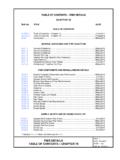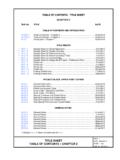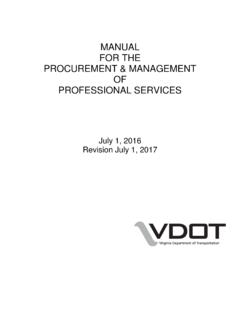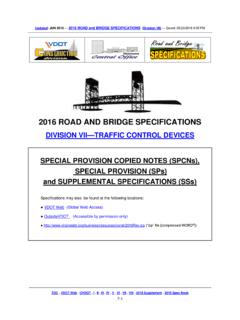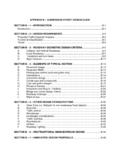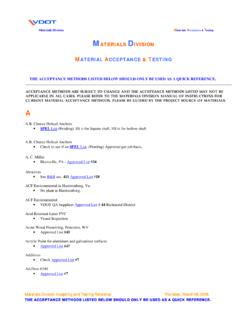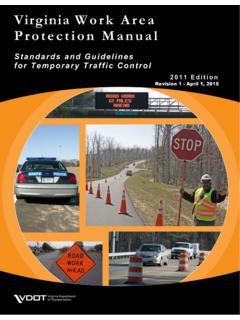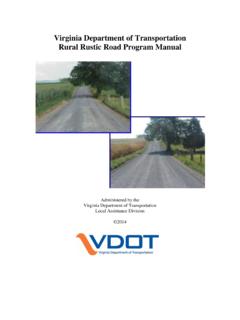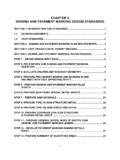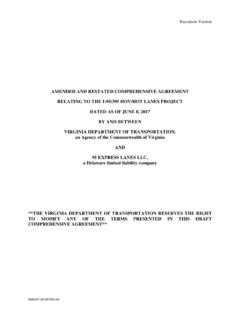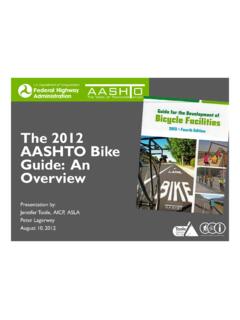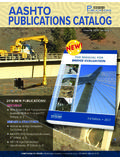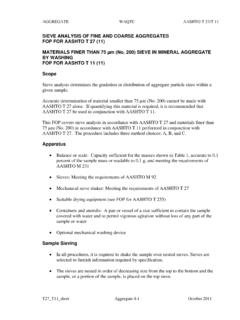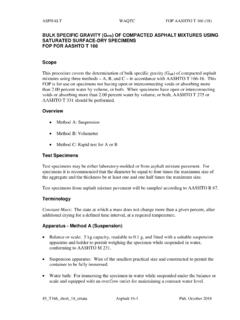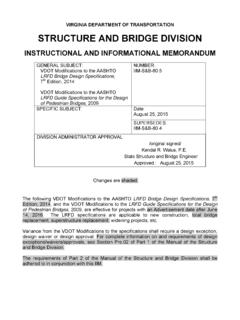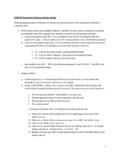Transcription of VIRGINIA DEPARTMENT OF TRANSPORTATION STRUCTURE AND BRIDGE ...
1 VIRGINIA DEPARTMENT OF TRANSPORTATION STRUCTURE AND BRIDGE DIVISION INSTRUCTIONAL AND INFORMATIONAL MEMORANDUM GENERAL SUBJECT: Ancillary Structures NUMBER: IIM-S& SPECIFIC SUBJECT: VDOT Guidelines to AASHTO Standard Specifications for Structural Supports for Highway Signs, Luminaries, and Traffic Signals, 6th Edition, 2013 with 2015 interims Date: April 28, 2016 SUPERSEDES: IIM-S& DIVISION ADMINISTRATOR APPROVAL: /original signed by/ /original signed by/ Kendal R. Walus, Raymond J.
2 Khoury, State STRUCTURE and BRIDGE Engineer State Traffic Engineer Approved: April 28, 2016 Approved: April 28, 2016 Changes are shaded. The following VDOT Guidelines to the AASHTO Standard Specifications for Structural Supports for Highway Signs, Luminaires, and Traffic Signals, 6th Edition (LTS-6), 2013 with 2015 interims, are effective for projects as stated below. Effective Date: Future contracts: This Memorandum shall be effective for all contracts with an advertisement on or after July 1, 2016. Existing contracts: Requirements in this Memorandum may be applied under existing contracts (including existing Regional Traffic Signal Construction Contracts) if the change is approved by the Project Engineer. Land use permit for private developments: this Memorandum shall be effective for all projects where the design is submitted to VDOT on or after July 1, 2016.
3 Design-Build or PPTA projects: this Policy shall be effective for projects with RFP released on or after July 1, 2016. Instructional & Informational Memorandum IIM-S& Sheet 2 of 10 General Requirements: Variance from the VDOT Guidelines to these specifications shall require a Design Waiver. For complete information on and requirements of Design Waivers, see Section of Part 1 of the Manual of the STRUCTURE and BRIDGE Division. Any AASHTO specification optional design parameter noted as may be used at the discretion of the owner that are not addressed in this document shall not be used for design. Square tube sign post, wood post, SSP-VA and SSP-VIA structures shall be provided in accordance with the requirements as shown in the VDOT Road and BRIDGE Standards. Lighting (conventional and high mast), signal (overhead, mast arm and span wire), pedestal poles, overhead (span, cantilever and butterfly) sign structures and ITS structures (camera poles, dynamic message signs (DMS), etc.)
4 Shall conform to the requirements of the AASHTO Standard Specifications for Structural Supports for Highway Signs, Luminaires, and Traffic Signals, 6th Edition (LTS-6), 2013 with 2015 interims with the following clarifications: SECTION 2: GENERAL FEATURES OF DESIGN: For additional requirements related to general features of design, see VDOT Road and BRIDGE Specifications, Section 700 and VDOT Road and BRIDGE Standards, Section 1300. See current IIM-S&B-89 for maximum span limits on ancillary structures and moratorium on BRIDGE mounted sign structures. SECTION 3: LOADS: Wind Loading: (LTS-6 Article and Appendix C) The alternate method for wind pressures provided in AASHTO Appendix C shall be used. Linear interpolation between wind contours is not permitted. The next higher contour shall be used for design.
5 Reduced forces shall not be used for free swinging traffic signal and free swinging sign wind loadings. See Appendix A for wind maps of VIRGINIA . For special wind regions in Bristol District shown on maps in Appendix A, the selection of the design wind speed shall consider localized effects. The minimum design wind speed for 50 year mean in these areas is 90 MPH, 25 year mean in these areas is 80 MPH and 10 year mean in these areas is 70 MPH. For BRIDGE mounted structures/light poles and other site condition where structures may be elevated above the surrounding terrain, the height factor used shall be increased to account for the increased wind effects. (LTS-6 Article ) Wind speeds using 50-year mean recurrence shall be used for all conventional light poles, high mast light poles, ITS device support poles and overhead sign structures (span, cantilever and butterfly).
6 Wind speeds using the 10-year mean recurrence shall be used for SSP-VA, SSP-VIA, square tube post and other ground mounted structures. Instructional & Informational Memorandum IIM-S& Sheet 3 of 10 SECTION 3: LOADS: (cont d) (LTS-6 Article ) Mast arm signal poles, mast arms, and strain poles shall be designed using the following wind speeds: VDOT Traffic Operations Region VDOT Districts Within That Region Design Wind Speed for strain poles, mast arms, and mast arm poles Southwest Bristol, Salem, and Lynchburg 70 MPH Northwest Staunton and Culpeper 70 MPH Northern Northern VIRGINIA 80 MPH Central Richmond and Fredericksburg 80 MPH Eastern Hampton Roads 90 MPH Mast arm signal pole and strain pole foundations shall be designed for wind speeds at the foundation location using the 25-year mean recurrence. SECTION 5: STEEL DESIGN: Laminated Structures: (LTS-6 Article ) Laminated or multi-ply structures shall only be used in tapered sections.
7 Holes and Cutouts (Unreinforced and Reinforced): (LTS-6 Article ) The location and size of hand holes and cutouts shall be in accordance with the details as shown in the VDOT Road and BRIDGE Standards. For high mast light poles, the width of unreinforced and reinforced holes and cutouts in the cross-sectional plane of the tube shall not be greater than 50 percent of the tube diameter at that section. Welding: A connection detail using a full penetration groove weld with a backing ring may be considered for signal mast arms and high mast light poles. The backing ring shall be attached at the top and bottom face of the ring using a continuous fillet weld. Instructional & Informational Memorandum IIM-S& Sheet 4 of 10 SECTION 11: FATIGUE DESIGN: Fatigue Importance Categories: (LTS-6 Article ) The following fatigue importance categories shall apply to structures: Fatigue Importance Categories STRUCTURE Type Span Length*, ft.
8 Fatigue Category All structures supporting dynamic message signs All span lengths Category I Overhead sign span STRUCTURE > 150 Category I 150 Category II Overhead sign cantilever STRUCTURE > 50 Category I 50 Category II Overhead sign butterfly STRUCTURE All span lengths Category II Signal mast arm STRUCTURE ** > 75 Category I 50 to 75 Category II < 50 No fatigue design required Overhead signal STRUCTURE > 190 Category I 190 Category II High mast light poles All lengths Category I Signal span wires, conventional lights poles and ITS device support poles (excluding DMS) No fatigue design required * Span length is defined as center-to-center of column(s) for span STRUCTURE and face-of-column to tip of arm for cantilever and signal structures. ** For twin mast arms, The pole, arms and connections shall be designed for the applicable fatigue category for the longest arm attached.
9 Mitigation Devices: (LTS-6 Article and ) Mitigation devices shall not be used in lieu of designing for fatigue. Aluminum Light Poles: (LTS-6 Article and ): Internal first and second mode vibration dampeners shall be provided and installed according to the manufacturer s instructions in all cases. External dampeners may be used if approved by the Engineer. Galloping Loads: (LTS-6 Article ) Galloping loads shall not be considered in the design of overhead sign cantilevered structures with four chord trusses, signal mast arm structures, and multi-chord overhead signal structures. Truck-Induced Gust Loads: (LTS-6 Article ) Truck induced gust loads shall not be considered in the design of signal mast arm and overhead signal structures. Vertical Deflection: (LTS-6 Article ) The vertical deflection of the free end of the arm for overhead sign cantilevered structures due to the wind load effects of galloping or truck-induced gusts shall not exceed 8.
10 Instructional & Informational Memorandum IIM-S& Sheet 5 of 10 Section 13: FOUNDATION DESIGN: (This section provides guidance/modifications on the AASHTO Standard Specifications for Highway Bridges, 1996; 1997 and 1998 Interim Specifications as referenced in the AASHTO Standard Specifications for Structural Supports for Highway Signs, Luminaires, and Traffic Signals.) Geotechnical Design: The factor of safety shall be as follows: MINIMUM FACTORS OF SAFETY Drilled Shaft Spread Footing Overhead Sign Structures and all other types of ancillary structures except for Mast arm traffic Signals Mast arm traffic Signals Tip resistance/Bearing pressure Torsion/Sliding/Skin Friction (1) (1) (2) Overturning (Broms Method) ((The factors of safety shown above already account for the group overload/overstress factor.))
